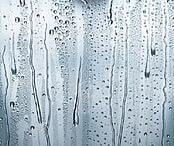 Condensation forms when humidity is so high that the air is saturated and can’t take on any more moisture. The solution to the problem is not complicated, but you need to be sure you are measuring the right variables to identify the best method to resolve it.
Condensation forms when humidity is so high that the air is saturated and can’t take on any more moisture. The solution to the problem is not complicated, but you need to be sure you are measuring the right variables to identify the best method to resolve it.
When does condensation become a problem?
There are a variety of situations where condensation tends to form and can become a serious problem:
- There may be production processes or cleaning operations that generate moisture or high humidity levels. When trapped in an enclosed space, they can build up to a point where the air becomes saturated. This can be a serious issue in the food industry, for example.
- When very humid air comes into contact with cold surfaces, or is introduced into a cold environment, for example in an unheated building, the humid air cools to its dew point and the moisture settles. This problem can become acute in situations such as unheated sports halls, where perspiration and respiration add even more moisture to the air.
When does condensation cease to be a problem?
When the air within the space regains its capacity to take on moisture, that is, it is no longer fully saturated.
How do you identify the solution?
You need to measure both temperature and relative humidity (the percentage that tells you how saturated the air is compared to its maximum possible saturation), and quantify the emission rate of the production process in the area. You can then develop the best solution, working closely with the building operator to understand what the target conditions should be, and if there are any other specific requirements that need to be factored in. As each building and process will have its own unique requirements, this is an instance when ‘one size doesn’t fit all’.
If you have a condensation problem, you can contact us for a free survey and we can help you find a simple and cost-effective solution.
 Paul Langford is an Engineering Director with experience in product development, manufacturing and testing for HVAC, solar shading, louvre systems and smoke control applications.
Paul Langford is an Engineering Director with experience in product development, manufacturing and testing for HVAC, solar shading, louvre systems and smoke control applications.

